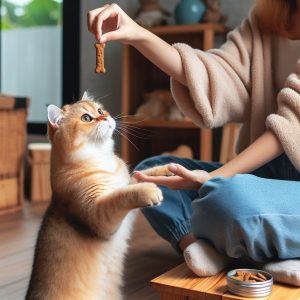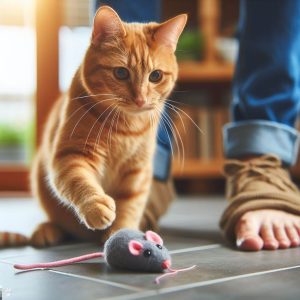For cat owners, especially those new to having feline friends, knowing whether or not a nursing cat can get pregnant again is crucial information. As much as we love our furry companions, accidental litters of kittens can be overwhelming.
Understanding a cat’s reproductive cycle and how to prevent unwanted pregnancies is an essential part of being a responsible pet owner. While cats can most certainly get pregnant while nursing, there are steps you can take to avoid endless cycles of pregnancy and nursing.
In this comprehensive guide, we’ll cover everything you need to know about cat reproduction, the signs that a nursing cat is in heat, and how to stop unwanted cat pregnancies.
A Cat’s Reproductive Cycle: The Keys to Feline Fertility
The fertility cycle of a female cat – also known as a queen – is quite different from that of humans and other mammals. Here’s a quick overview of how cat reproduction works:
Cats Are Induced Ovulators
Unlike humans, cats do not ovulate on a regular schedule. They are induced ovulators, meaning the act of mating triggers the release of eggs for potential fertilization.
So for cats, ovulation occurs during – not before – breeding. This is a key factor in understanding their fertility cycle.
cats Can Get Pregnant Quickly After Giving Birth
Cats are also unique in that they can get pregnant quite soon after delivering a litter. While humans experience a period of infertility post-partum, cats come back into heat within 2 to 8 weeks after giving birth.
This short period between pregnancies allows them to produce several litters each year. This is why it’s so important to spay female cats as soon as possible, unless you intend to responsibly breed purebred cats under careful guidance.
Signs Your Cat Is in Heat
Cats typically come into heat multiple times year, starting as young as 4 months old. The signs your cat is in heat and ready to mate include:
- Increased vocalization like yowling and meowing
- Restlessness and irritability
- Excessively grooming and rubbing against objects
- Raising hindquarters when stroked near the base of the tail
- Decreased appetite
If you notice these behaviors right after your cat has given birth, she may be fertile again even if she is still nursing kittens.
Mating Induces Ovulation
The takeaway is that mating causes the ovaries to release eggs, which the male cat’s sperm can then fertilize. So as long as the nursing mother mates, she can potentially get pregnant again.
Now that we’ve covered the unique aspects of feline fertility, let’s look specifically at whether nursing cats can get pregnant.
Can Cats Mate While Nursing?
Given their reproductive cycle, the short answer is yes – cats absolutely can get pregnant while nursing their kittens if they mate during this time.
Nursing does not reliably prevent or delay ovulation and heat cycles in cats. The hormones produced during nursing may prolong the return to fertility slightly, but not completely inhibit it.
Some key points on mating while nursing:
- Female cats typically come into heat 2-8 weeks after giving birth, even when nursing.
- They will still ovulate and be fertile if they mate during this period.
- If allowed outdoors unsupervised, nursing mother cats can easily get pregnant again. This is why vigilance is so important.
- Mother cats should be separated from male cats for at least 8 weeks after giving birth to avoid becoming pregnant while nursing.
So while nursing may delay the return to fertility temporarily, it does not prevent it if the cat mates. The only sure ways to avoid pregnancy are separating nursing cats from males or spaying the mother cat.
Next, let’s go over the signs that your nursing cat may be in heat and ready to breed again.
Signs a Nursing Cat Is in Heat Again
Nursing cats generally come back into heat anywhere from 2 to 8 weeks after delivering their kittens.
Here are some common signs your nursing cat may be going into heat again:
- Decreased appetite – She may eat less food due to hormones affecting her appetite.
- Restlessness – She may pace, vocalize, or try to escape or seek out male cats. Mother cats become highly restless when in heat.
- Swollen vulva – The genital area swells and enlarges when in heat.
- Excessive vocalizing – Loud yowling and meowing, more than normal.
- Decreased milk production – You may notice the kittens nursing less as milk supply drops due to hormones.
- Repeated mating behaviors – Rubbing against objects, raising hips, and treading hind legs.
- Attempts to escape – To find mate opportunities outdoors, a sign of urgency.
If you notice multiple signs of heat in your nursing cat, take steps to separate her from male cats. Consult your vet about spaying options ASAP.
Now let’s go over some tips on how to prevent unwanted pregnancies while your cat is nursing.
How to Prevent Pregnancy While Nursing
Allowing your nursing cat to get pregnant again too soon can jeopardize her health and the well-being of her kittens. Here are some tips to avoid back-to-back litters:
Separate From All Male Cats
This is the most reliable way to prevent mating and pregnancy. Isolate nursing cats from male cats for 8 full weeks after giving birth. Even short periods of access can allow mating and impregnation.
Confine Her Indoors
Do not allow your nursing cat outside unsupervised where she could encounter and mate with male cats. Keep her strictly indoors until she can be spayed.
Spay as Soon as Possible
Schedule spaying within 2-3 weeks after delivering her litter. This allows time for milk supply and kitten nursing to become established before surgery.
Monitor for Signs of Heat
Keep an eye out for any signs your nursing cat may be in heat again like restlessness, decreased appetite, and vocalizing. Separate her immediately if you suspect she’s in heat.
Ask Your Vet About Options
Discuss medicated heat prevention, early spaying, or other options with your vet. There may be appropriate solutions for your cat’s situation.
With vigilance and proactive steps, you can avoid exhausting back-to-back pregnancies for your nursing cat. Next let’s look at why it’s so vital to curb unwanted cat pregnancies.
Risks of Continuous Pregnancies and Nursing Cycles
Mother cats who are constantly pregnant and nursing face increased strain and health risks. Here are some of the concerns:
Depletes the Mother’s Nutrients
Pregnancy and nursing require massive amounts of nutrients and calories. Back-to-back litters rapidly deplete the mother’s nutrient stores, which can lead to malnutrition.
Higher Risk of Disease
The constant stress leaves nursing cats prone to illness. Upper respiratory infections and other contagious diseases can rapidly spread among vulnerable cats.
Weakens the Mother Over Time
The physical strain of repeated pregnancies takes its toll. The mother can become severely weakened and emaciated over time.
Hinders Kittens’ Development
Kittens need time and attention from their mother to properly develop. Too-frequent pregnancies mean less care and attention for each litter.
Increases Behavior Issues
Constant cycles of nursing then separation from kittens is stressful. This can lead to psychological issues like anxiety, aggression, or neglect of kittens.
Clearly, allowing ongoing pregnancies is detrimental to both mother cat and kittens alike. It leaves the cat vulnerable to health complications that can shorten her lifespan.
Spaying Cats: When and Why It’s Recommended
To avoid the risks of back-to-back cat pregnancies, timely spaying of your pet is crucial. Here’s what you should know about spaying cats:
What is Spaying?
Spaying, also known as ovariohysterectomy, involves surgical removal of the ovaries and uterus. This completely prevents a female cat from going into heat and getting pregnant. It’s a common procedure done routinely in cats.
Age to Spay Your Cat
Ideally, cats should be spayed by 5 months of age, before their first heat cycle. Spaying is safe and well-tolerated from 8 weeks old onward. The benefits of early spaying outweigh any minimal risks.
When to Spay a Nursing Cat
Nursing mother cats can be safely spayed 2-3 weeks after giving birth, once the kittens are nursing consistently. This prevents future unplanned pregnancies.
Benefits of Spaying Your Cat
Spaying provides major health and behavioral benefits. Spayed cats have zero risk of uterine infections, cancers, or problem pregnancies. Spaying eliminates heat cycles and mating behaviors like yowling and restlessness. It also helps curb the overwhelmed cat population crisis.
Risks of Spaying
There are some minimal risks, including bleeding or infection. But when performed by an experienced vet, complications are quite rare. Benefits far outweigh any small risks for most cats. Discuss any specific concerns with your veterinarian.
In summary, timely spaying – ideally before first heat or soon after nursing – is crucial for population control and your cat’s health. Don’t hesitate to speak to your vet about the ideal timing for your pet.
Frequently Asked Questions About Cats Mating While Nursing
Many new cat owners have additional questions about mating behaviors, heat cycles, and pregnancy in nursing mother cats. Here are some commonly asked questions.
How Soon After Giving Birth Can Cats Go Into Heat?
Most cats come back into heat within 2-8 weeks of giving birth. Even while nursing, their fertility returns very quickly and they can go back into heat. Some cats oven go into heat shortly before giving birth when hormone levels drop.
Can Cats Get Pregnant While Still Bleeding After Giving Birth?
It’s uncommon, but possible. Some cats ovulate and go into heat while still having post-partum vaginal discharge, which can last ~2 weeks after birth. If she mates during this time, pregnancy is possible but less likely due to hormones.
Can a 4 Week Old Kitten Get a Cat Pregnant?
No, kittens cannot impregnate female cats. Tomcats do not become sexually mature and able to breed until around 5-7 months old. A 4 week old kitten is still nursing and far too young to impregnate a female cat.
How Often Do Cat Heats Occur?
When not pregnant or nursing, cats typically go into heat every 2-3 weeks during breeding season, which is spring and summer in most areas. In warmer climates, cats may cycle all year long. Spaying prevents all these cycles.
Do Cats Reabsorb Their Litters While Nursing?
Rarely, some mother cats may reabsorb a litter shortly after birth if faced with extreme stress or malnutrition. The kittens are resorbed in the uterus to conserve resources. However, this is quite uncommon and should not be expected. Most cats can healthily nurse simultaneous litters.
Key Takeaways: Preventing Pregnancy in Nursing Cats
To summarize everything we’ve covered, here are the key facts to remember:
- Female cats can absolutely get pregnant while nursing, because mating triggers ovulation.
- Mother cats come back into heat as soon as 2-8 weeks after giving birth.
- Isolate nursing cats from all male cats for at least 8 weeks to prevent unwanted pregnancy.
- Spay your cat as soon as possible – ideally before her first heat, or within 2-3 weeks after giving birth. This is critical for population control and her health.
- Monitor your nursing cat for signs of heat like restlessness, decreased appetite, and vocalizing. Separate her immediately if concerned.
- Discuss medicated heat prevention or other options with your vet as needed.
With proper precautions, you can ensure your nursing cat avoids expenditures of back-to-back litters. Don’t hesitate to contact your veterinarian for guidance tailored to your pet’s needs. Here’s to happy, healthy kitties and responsible cat ownership!



